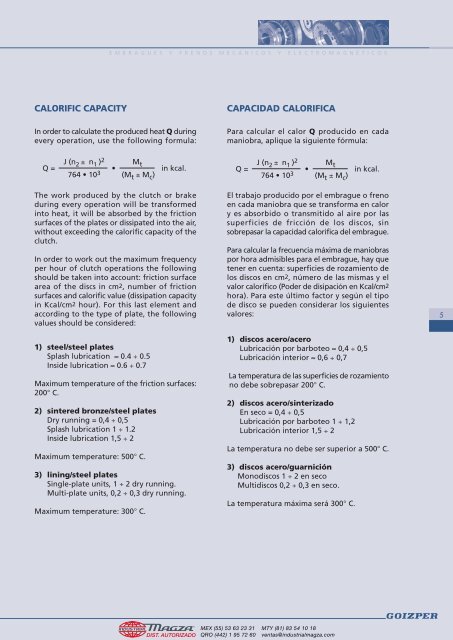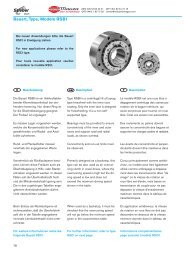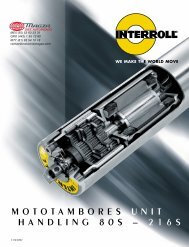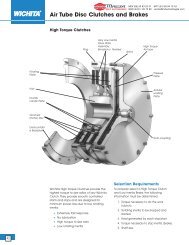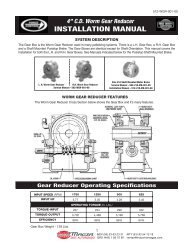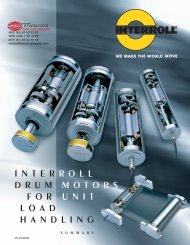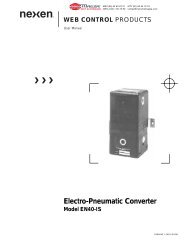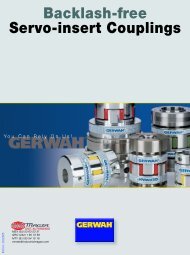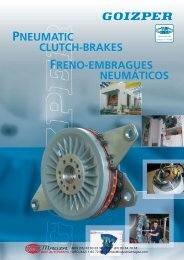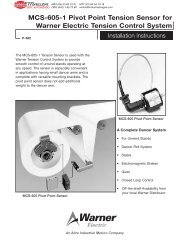Embragues y Frenos Mecanicos y Electromagneticos - Industrial ...
Embragues y Frenos Mecanicos y Electromagneticos - Industrial ...
Embragues y Frenos Mecanicos y Electromagneticos - Industrial ...
Create successful ePaper yourself
Turn your PDF publications into a flip-book with our unique Google optimized e-Paper software.
E M B R A G U E S Y F R E N O S M E C Á N I C O S Y E L E C T R O M A G N É T I C O S<br />
CALORIFIC CAPACITY<br />
In order to calculate the produced heat Q during<br />
every operation, use the following formula:<br />
CAPACIDAD CALORIFICA<br />
Para calcular el calor Q producido en cada<br />
maniobra, aplique la siguiente fórmula:<br />
Q =<br />
J (n 2 ± n 1 ) 2 M t<br />
•<br />
764 • 10 3 (M t ± M c )<br />
in kcal.<br />
Q =<br />
J (n 2 ± n 1 ) 2 M t<br />
•<br />
764 • 10 3 (M t ± M c )<br />
in kcal.<br />
The work produced by the clutch or brake<br />
during every operation will be transformed<br />
into heat, it will be absorbed by the friction<br />
surfaces of the plates or dissipated into the air,<br />
without exceeding the calorific capacity of the<br />
clutch.<br />
In order to work out the maximum frequency<br />
per hour of clutch operations the following<br />
should be taken into account: friction surface<br />
area of the discs in cm2, number of friction<br />
surfaces and calorific value (dissipation capacity<br />
in Kcal/cm2 hour). For this last element and<br />
according to the type of plate, the following<br />
values should be considered:<br />
1) steel/steel plates<br />
Splash lubrication ≈ 0.4 ÷ 0.5<br />
Inside lubrication ≈ 0.6 ÷ 0.7<br />
Maximum temperature of the friction surfaces:<br />
200° C.<br />
2) sintered bronze/steel plates<br />
Dry running = 0,4 ÷ 0,5<br />
Splash lubrication 1 ÷ 1.2<br />
Inside lubrication 1,5 ÷ 2<br />
Maximum temperature: 500° C.<br />
3) lining/steel plates<br />
Single-plate units, 1 ÷ 2 dry running.<br />
Multi-plate units, 0,2 ÷ 0,3 dry running.<br />
Maximum temperature: 300° C.<br />
El trabajo producido por el embrague o freno<br />
en cada maniobra que se transforma en calor<br />
y es absorbido o transmitido al aire por las<br />
superficies de fricción de los discos, sin<br />
sobrepasar la capacidad calorifica del embrague.<br />
Para calcular la frecuencia máxima de maniobras<br />
por hora admisibles para el embrague, hay que<br />
tener en cuenta: superficies de rozamiento de<br />
los discos en cm2, número de las mismas y el<br />
valor calorífico (Poder de disipación en Kcal/cm2<br />
hora). Para este último factor y según el tipo<br />
de disco se pueden considerar los siguientes<br />
valores:<br />
1) discos acero/acero<br />
Lubricación por barboteo ≈ 0,4 ÷ 0,5<br />
Lubricación interior ≈ 0,6 ÷ 0,7<br />
La temperatura de las superficies de rozamiento<br />
no debe sobrepasar 200° C.<br />
2) discos acero/sinterizado<br />
En seco = 0,4 ÷ 0,5<br />
Lubricación por barboteo 1 ÷ 1,2<br />
Lubricación interior 1,5 ÷ 2<br />
La temperatura no debe ser superior a 500° C.<br />
3) discos acero/guarnición<br />
Monodiscos 1 ÷ 2 en seco<br />
Multidiscos 0,2 ÷ 0,3 en seco.<br />
La temperatura máxima será 300° C.<br />
5<br />
DIST. AUTORIZADO<br />
®<br />
MEX (55) 53 63 23 31<br />
QRO (442) 1 95 72 60<br />
MTY (81) 83 54 10 18<br />
ventas@industrialmagza.com


